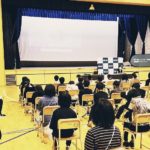VIII Ending of the project and new support
The Houses for Hiroshima project constructed 15 buildings (21 houses). As shown in the table below, more than 300,000 dollars in donations was received from all over the world from 1949, when the project started, to 1952. 17 volunteers visited Japan from America. In addition, eight Japanese people studied in America after this project 88.
50 Construction status of the Houses for Hiroshima project
| Built Year | Location (Current name) |
Number of building | Houses | Purpose (at the beginning of construction) |
| 1949 | Minami-machi 1-chome | 2 | 4 | Houses for atomic bomb victims |
| 1950 | Ebahigashi-machi 1-chome |
1 | 1 | Houses for atomic bomb victims (show house) |
| Ebanihonmatsu 1-chome |
7 | 7 | Houses for atomic bomb victims | |
| 1951 | Ebanihonmatsu 1-chome |
1 | 1 | Houses for atomic bomb victims |
| 1 | 1 | Community house (present day Schmoe House) |
||
| 1952 | Ebanihonmatsu 1-chome |
1 | 2 | Houses for atomic bomb victims |
| Ushitahigashi 2-chome |
1 | 4 | Houses for atomic bomb victims | |
| 1953 | Ushitahigashi 2-chome |
1 | 1 | Guesthouse |
| Total | 15 | 21 |
The Houses for Hiroshima project ended in 1953. This year’s city guide reported that the number of houses in Hiroshima was 73,000, adding nearly 20,000 new houses in five years89. Houses for Hiroshima were also included in the number. However, the project ended not because the housing shortage in Hiroshima was solved. It was because Schmoe needed to take part in a relief activity in Korea which was devastated in the Korean War occurred in 195090. Receiving support from the United Nations’ Korean relief work administration and other individuals, Schmoe started the Houses for Korea project. He built houses, dug wells and repaired roads for people residing in the areas which were destroyed by attacks from 1953 to 1956. He also established a clinic91. Schmoe further continued the relief projects for people injured in war. In 1956 when the Suez Crisis broke out, he visited Egypt in order to help 4,000 people who lost their homes in airstrikes. He dug a well which was buried because of an attack and purchased a pump for water supply so that victims were able to live in a new place. People drew water from the well and planted citrus fruits, dates, olives, etc., and many families lived there92.
After the Egypt project, Schmoe finished his career93. Starting with the support for Japanese Americans during World War II, without a break, he had devoted himself to support activities for decades in Hiroshima, Nagasaki, Korea and Egypt, with sympathy for war victims.
However, his passion never died. Schmoe established peace parks in Tashkent, Uzbekistan and Seattle, which was his home town. In the peace park in Seattle, there is a bronze statue of Sadako Sasaki, who died from leukemia 10 years after the atomic bombing94.
88 Floyd Schmoe“HOUSES FOR HIROSHIMA PROGRESS REPORT NOVEMBER 1952” Floyd W. Schmoe Papers, 1903-1993 University of Washington Libraries, Special Collections Accession No.0496-008 Box12 Folder 16
89 Hiroshima City, Shouwa 28 Nendo Hiroshimashi Shisei Gaiyou (1953 City Guide of Hiroshima),1953, p31
90 Floyd Schmoe“HOUSES FOR HIROSHIMA PROGRESS REPORT NOVEMBER 1952” Floyd W.Schmoe Papers, 1903-1993 University of Washington Libraries, Special Collections Accession No.0496-008 Box12 Folder 16
91 Kit Oldham “Schmoe, Floyd W. (1895-2001)”History Link.org Essay 3876 http://www.historylink.org/File/3876
92 Transcript of Kitty Barragato, Interview of Floyd Schmoe “Oral History Interview # 21”February 25,1989 Collection of American Friends Service Commitee
93 Transcript of Kitty Barragato, Interview of Floyd Schmoe “Oral History Interview # 21”February 25,1989 Collection of American Friends Service Commitee
94 Kit Oldham “Schmoe, Floyd W. (1895-2001)”History Link.org Essay 3876 http://www.historylink.org/File/3876








